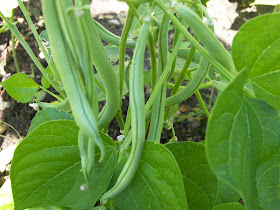Daylily (Hemerocallis L.)
Yesterday
Maximum Temp: 102 ºF
Minimum Temp: 66 ºF
Realtive Humidity: 20%
Today
Maximum Temp: 99 ºF
Minimum Temp: 64 ºF
Relative Humidity: 17%
It is that time of the year again when being in the garden is almost like being in a furnace.
Plants love the sun. Plants are plants because of the sun and the heat energy they derive from it. To most plants summer is heaven. In addition to the abundance of sunshine, temperature also increases the rate of photosynthesis or production. That's what plants love to do. But anything good especially in excess always comes with a price. Intense sunlight which is accompanied by high temperatures jeopardizes the availability of water to the plant.
Ground water dissipates from the ground through evaporation while absorbed water escapes the plants through transpiration at a high rate. Ideally, natural weather conditions would provide replacement of lost water through precipitation. My garden is not so ideally located when it comes to rainfall. Affected by the Mediterranean climate, California's subtropical environment is characterized by a dry summer. The example of weather condition above shows how dry it is here by the relative humidity of lower than 20%. Gardening here requires some techniques to beat the heat during the dry months.
Adjust watering schedule.
1. Water less frequently but deeply to encourage the roots to grow deeper.
2. Water during the cooler times of the day/night to avoid loss by evaporation.
3. Drip irrigate to avoid runoff especially where the soil is on a slope.
4. Check irrigation pipes for leaks and breakage.
Mulch.
Mulching is the simply the process of spreading a protective layer of material on top of the soil. It is an effective way to conserve soil moisture, reduce soil temperature, and prevent weed growth. There are several materials available at your local nursery or home improvement center. When using organic materials (those that are derived from plant and animal by-products) mulching eventually improves the water-holding capacity of the soil.
Use what is available and free. In my garden I use dried grass clippings for mulching instead of throwing them away. It has to be dry before they are used to mulch shallow rooted plants but you can directly use fresh clippings to mulch around trees or in opens spaces. Coffee grounds also make a good mulch material; I use them for mulching potted plants. Coffee shops such as Starbucks and Peets Coffee offer coffee grounds for free. Sometimes they already in bags ready for anyone interested.
Protect potted plants.
Potted plants are
"caged" and they have limited space to hunt for resources particularly water. During the hot months of summer, it is best to move them to a place where they can get some shade. This will reduce water loss through excessive transpiration and evaporation.
And then fertilize...
Frequent watering depletes the soil from the essential nutrients especially those in pots. Applying fertilizer on a regular basis benefits the plants. It is not enough to provide water for the plants. The nutrients they need have to be available also for continued growth and development. The potted orange trees in my yard are great examples. After a couple of months into the warmer months, the leaves show signs of yellowing which is a symptom of nitrogen deficiency. A little bit of complete fertilizer quickly restores the nice green coloration of the leaves.
Summer gardening is fun as long as we beat the effects of high temperatures.





































